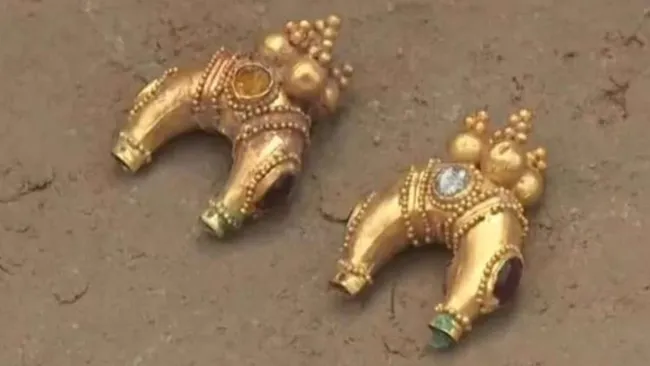Gold jewelry, bronze mirror, and arrowheads from a mysterious culture dating back approximately 2,000 years have been discovered in the Turkistan region of southern Kazakhstan by archaeologists.
These artifacts are believed to have originated during the Kangju state’s reign, a relatively obscure civilization that governed the area from the 5th century B.C. to the 4th century A.D.
Officials from the regional government in Turkistan revealed that these findings showcase the advanced craftsmanship prevalent in the region during the Kangju era, characterized by extensive trade relations with ancient Rome, China, and the Kushan Empire to the south.
The bronze mirror, notably crafted in a circular shape with an eight-sided arched pattern on its back and a central hole for threading, is speculated to have Chinese origins from the Han dynasty’s era (206 B.C. to A.D. 220). Similar mirrors have been uncovered in Afghanistan and the southern Ural region, suggesting their widespread value across Eurasia. Its presence alongside a wealthy woman in her burial indicates her affluent and influential status.
A joint effort between Ozbekali Zhanibekov University and local government archaeologists led to the discovery of these artifacts in three burial mounds within Turkistan’s Ordabasinsky district. Although two mounds had been previously looted, the third mound yielded significant relics.
Apart from the bronze mirror, the findings include a Roman-style fibula brooch, beads of varying sizes, a pottery jug, a shoe, a belt buckle, a bird-hunting arrowhead, and two intricately designed gold earrings, likely dating back to the 1st century B.C.
The earrings, particularly elaborate, are crafted from polychromatic gold, adorned with turquoise and rubies, shaped like crescents to symbolize the moon, with additional motifs representing grape clusters to catch and reflect sunlight.
Aleksandr Podushkin, the lead archaeologist from Ozbekali Zhanibekov University, described the Kangju state as a federation comprising diverse ethnic groups, including nomadic Sarmatians, Xiongnu, and possibly Scythian Saki tribes. Their strategic positioning along the Great Silk Roads facilitated extensive diplomatic and trade connections spanning from China to the Mediterranean.
These artifacts will be showcased at the National Museum of the Republic of Kazakhstan in Astana, according to Podushkin.

